Furiosa: A Mad Max Saga
“As the world falls around us, how must we brave its cruelties?” — The History Man, some time long after the Fall.
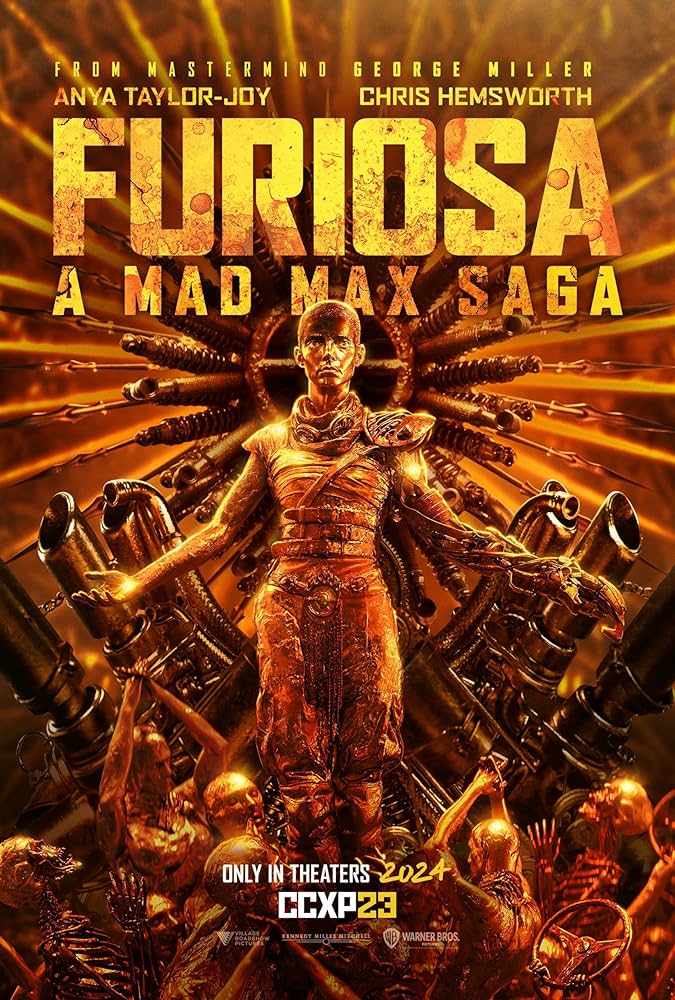
“My life fades. The vision dims. All that remains are memories. I remember a time of chaos and ruined dreams and this wasted land. But most of all, I remember The Road Warrior. The man we called Max. To understand who he was, you have to go back to another time, when the world was powered by the black fuel, and the desert sprouted great cities of pipe and steel. Gone now... swept away. For reasons now long forgotten, two mighty warrior tribes went to war, touching off a blaze which engulfed them all. Without fuel they were nothing. They had built a house of straw. Their thundering machines sputtered and stopped. Their leaders talked and talked and talked... but nothing could stem the avalanche. Their world crumbled. Their cities exploded. It was a whirlwind of looting, a firestorm of fear. Men began to feed on men. On the roads it was a white line nightmare. Only those mobile enough to scavenge, brutal enough to pillage, would survive. The gangs took over the highways, ready to wage war for a tank of juice. And in this maelstrom of decay, ordinary men were battered and smashed... men like Max, the warrior Max. In the roar of an engine, he lost everything, and beame a shell of a man... a burnt-out, desolate man, haunted by the demons of his past, a man who wandered out into the wasteland to die. But it was here, in this blighted place, that he learned to live again…” — The Leader of The Great Northern Tribe, The Road Warrior (1981)
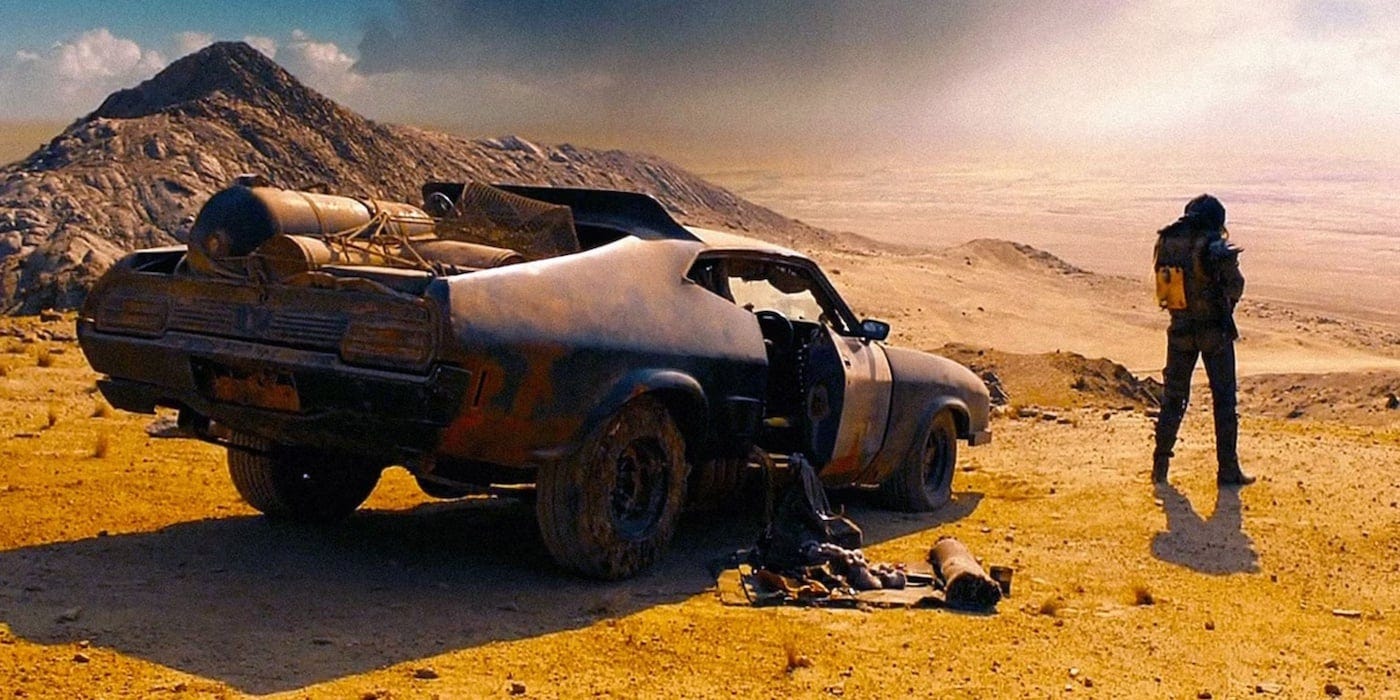
If I ever wanted to dedicate a piece of art to my original creative influences, I’d write it as: “To the Three Georges, a Stephen, and a Stan.” This refers to Stan Lee, Stephen King, George Lucas, George Romero, and of course, George Miller, all of whom were the source of early experiences with fiction that both opened my young mind, and set the foundation of what I like to this day.
So, that having been said, it should come as no surprise when I say that, for me, the Mad Max films are not only some of the best action films of all time, but they are also some of my favorite movies too. Furiosa is the latest in his post-apocalyptic dystopian action franchise that depict a world that has become a “white-line nightmare” on the open road.
And with all that also having been said, unlike many of my other favorite franchises, the Mad Max movies have never disappointed me, so if you disagree with any of what I’m going to say here, feel free to take it all with the aforementioned grains of salt, or just fuck off. Either one is cool with me.
So…
Beginning in Melbourne, Australia in the late 1970s, the whole thing started with a short story by Miller and producer Byron Kennedy about a cop turned vigilante that was set in a dystopian near-future Australia in the middle of a societal collapse. The story was inspired not just by the gas shortages of the 1970s, but by some of the things that George Miller saw while he was working as an EMT, and now, years later, there are five movies in the series…
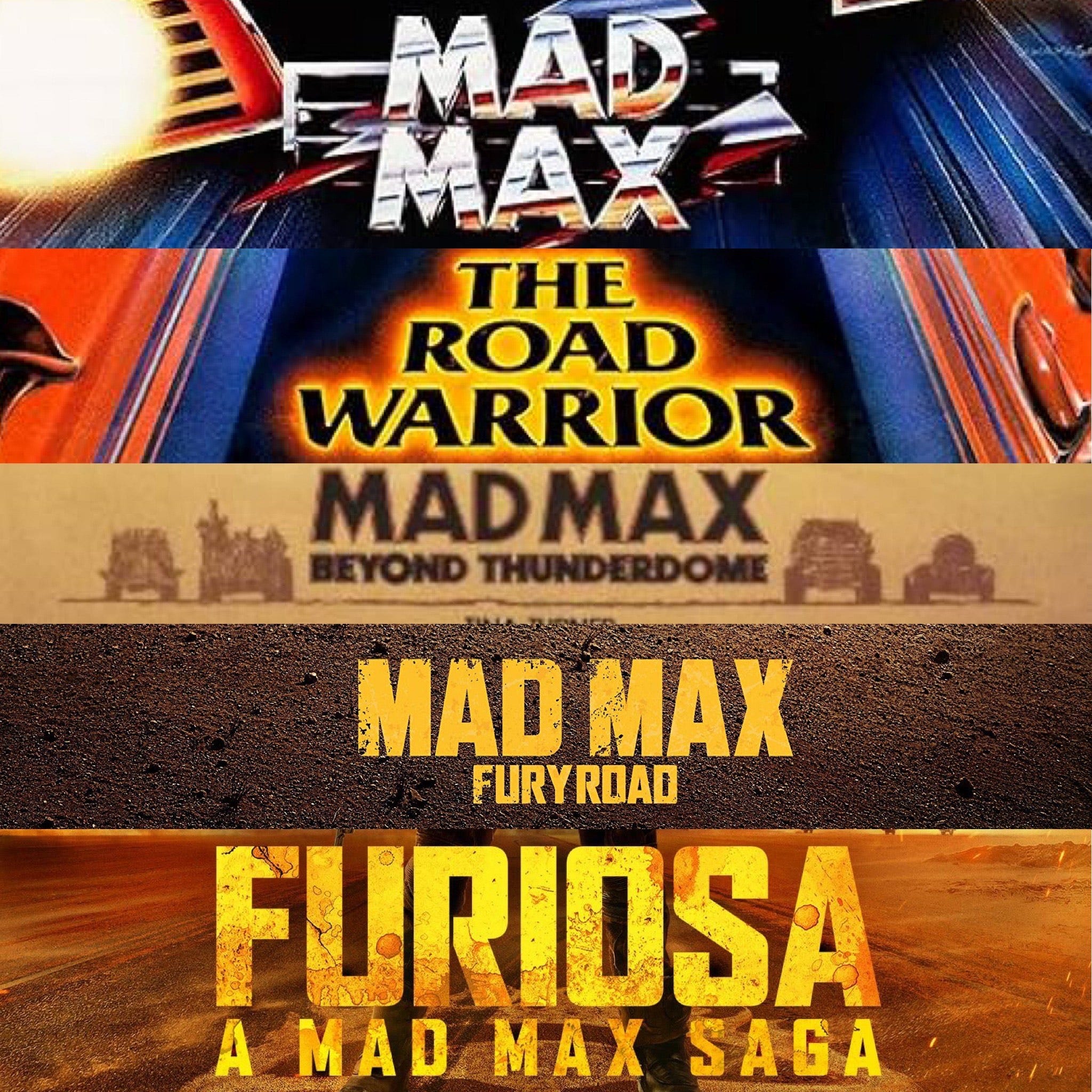
Besides pretty much creating it’s own sub-genre of film—whether it’s called dieselpunk, or desertpunk, or my personal favorite, road war—as well as being directly responsible for launching seemingly no end of cheap imitators, these films are mostly known for the distinctive punk rock/leather daddy/demolition derby appearance of its world. Among fans, it’s also known for its vague narrative timeline, as well as its non-linear stories, which are often riddled with retcons and contradictions, a lot of which are often amplified, or negated, in other sources, like in the tie-in novels, comics, and video games. This franchise is also known for being a little unclear when it comes to how much time has passed between the films, as well as for featuring multiple actors playing multiple characters, sometimes in different films, and sometimes in the same film. It is, in many ways, a unique franchise.
To me, the ambiguous nature of this franchise’s overarching storyline is best dealt with by thinking of the respective films (in a meta-sense) not so much as being a part of a more traditional linear narrative, but as something more akin to a collection of half-remembered, second-hand legends that are being told around a campfire after the collapse of the world. Much like with Verhoeven’s Starship Troopers—where the key to understanding the whole point of the film is to watch it as if you are sitting in the audience in the world of the film and you are watching their fascist propaganda, like a sci-if Triumph of the Will—with the Mad Max stories, you have to imagine them as if they are being recounted to you by an unreliable narrator, while you’re all sitting in the rubble of the old world, and that narrator is someone who can only tell the story to you in the way that they themselves know, which is rooted in knowledge that has also come from an unreliable source.
What I’m saying here is that the timeline in these films makes no sense, and there’s no way to reconcile that, so let it go.
Meanwhile, the biggest problem with this franchise is one that is unavoidable. Yes, Mel Gibson is an antisemitic piece of shit, but I’ve decided I’m okay with holding on to the original films in this series. I don’t watch any of the new things that have Mel Gibson in it, and at this point, it’s clear that Hollywood is never going to stop casting him in things, so fuck it, but also, I absolutely understand if others are not as willing to do the same in this case.
Mad Max (1979)
In a dystopian future 1985, one of the last good cops (which is how you know it’s a fantasy…) struggles to hold the tattered remnants of law and order together as the world collapses around them. But when his wife and son are run down by a vicious biker gang terrorizing the area, Max Rockatansky goes “mad” and gets behind the wheel of his iconic black GT Falcon, the Pursuit Special, last of the V8 Interceptors, and puts the pedal to the metal on the road to bloody revenge, leaving burning hulks of twisted metal in his wake…
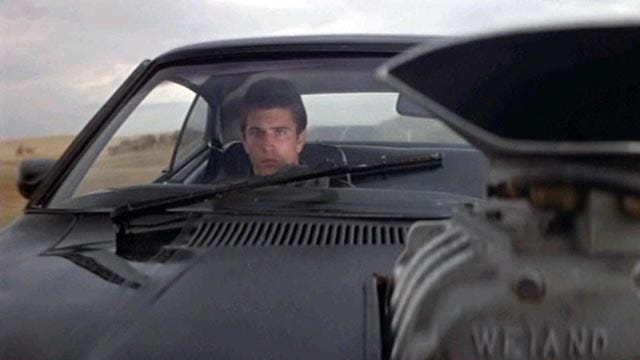
Reportedly filmed for a budget of only $400,000 (Australian), Mad Max went on to make more than $100 million (U.S.) worldwide, setting a Guinness World Record for the highest box-office-to-budget ratio of any motion picture, a record that held for twenty years, until the release of The Blair Witch Project in 1999.
Opening with the classic sci-fi caption of “a few years from now,” a graffitied road sign is dated December 1984, so it’s fair to assume that the film is set in the mid-80s, most likely 1985. At the time that the story starts, the world is spiraling the drain, the result of a slow social and economic global breakdown sparked by a dramatic drop in oil production, otherwise known as “spoilers for a decade or so from now.” This lack of fuel has led to wars breaking out across the globe, and to a rise in social unrest and violent crime at home, as a general lawlessness on the fringes of society has begun to slowly creep inwards, threatening the “nice” neighborhoods.
Unlike the other movies in this series, this film is set in a recognizable society. It’s still green and wet. There’s grocery stores, restaurants, repair shops, hospitals, and bars. You can still get ice cream. There’s active law enforcement, a legal system, and the courts, and even if the cops are very obviously falling apart, fighting a losing battle against the end of the world, it’s still a time where you can take a family vacation. But it’s also a world where that peace and tranquility can be suddenly and irrevocably shattered after randomly crossing paths with a violent gang of outlaw bikers.
This is the beginning of a world where there will only be one law… one where only those who are strong enough, and cruel enough, will survive.
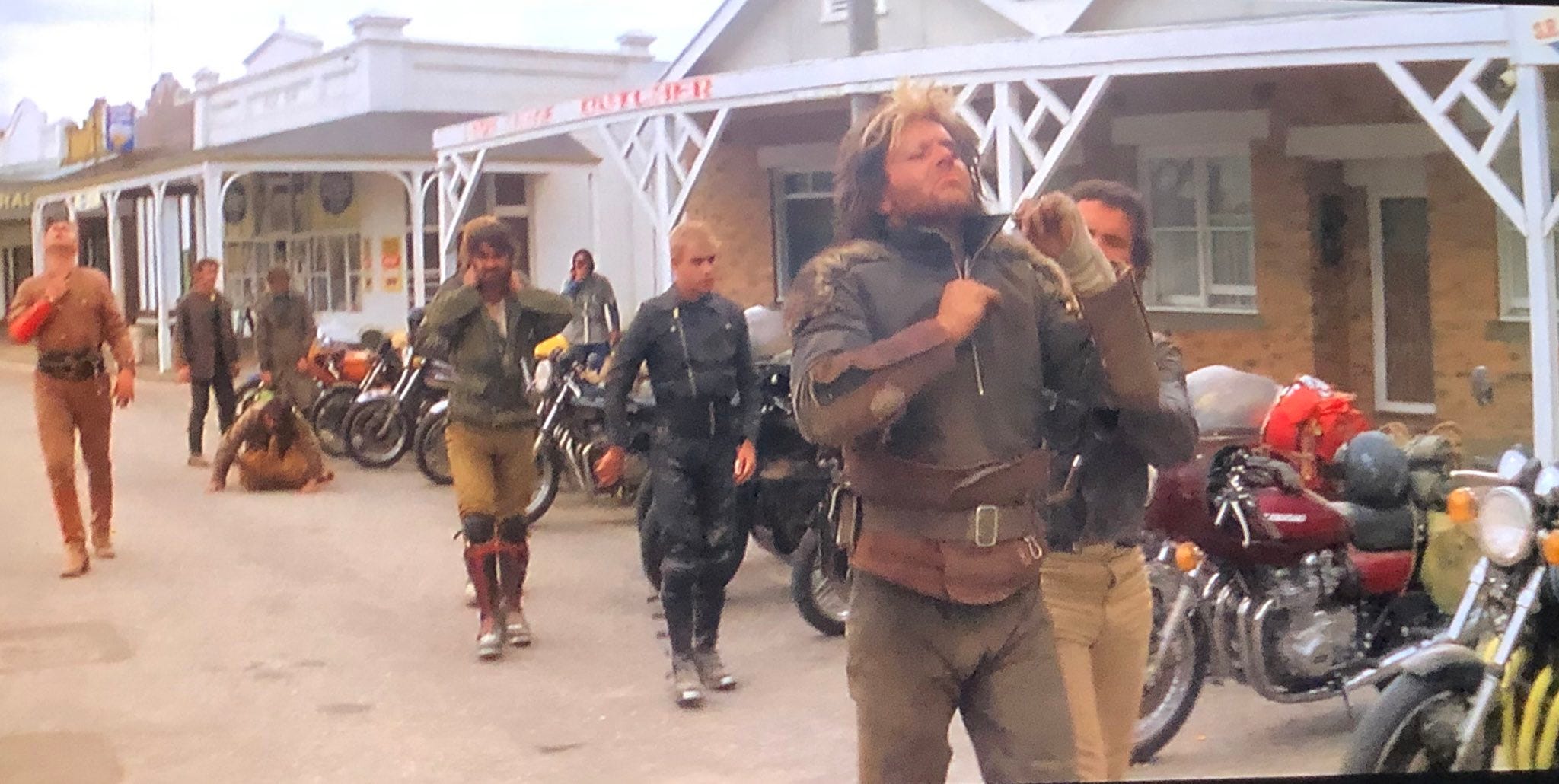
The Roadwarrior (1981)
After avenging the death of his wife and infant son, Max Rockatansky drove off into the wasteland to die. In the years since, despite living in a near constant state of high-speed, high-octane road war waged against the scavengers and raiders who hunt along the sun-baked blacktop of the wasteland highways, nothing has been able to kill him yet. So, Max keeps driving, always searching for gas, living day by day, scavenging off the ruins of the old world. But when he happens across a peaceful encampment that is being threatened by a warlord known as The Humungus, a hulking burn-victim in a hockey mask and leather hot-pants, the leader of a horde of post-apocalyptic barbarians, Max finds a new reason to live.
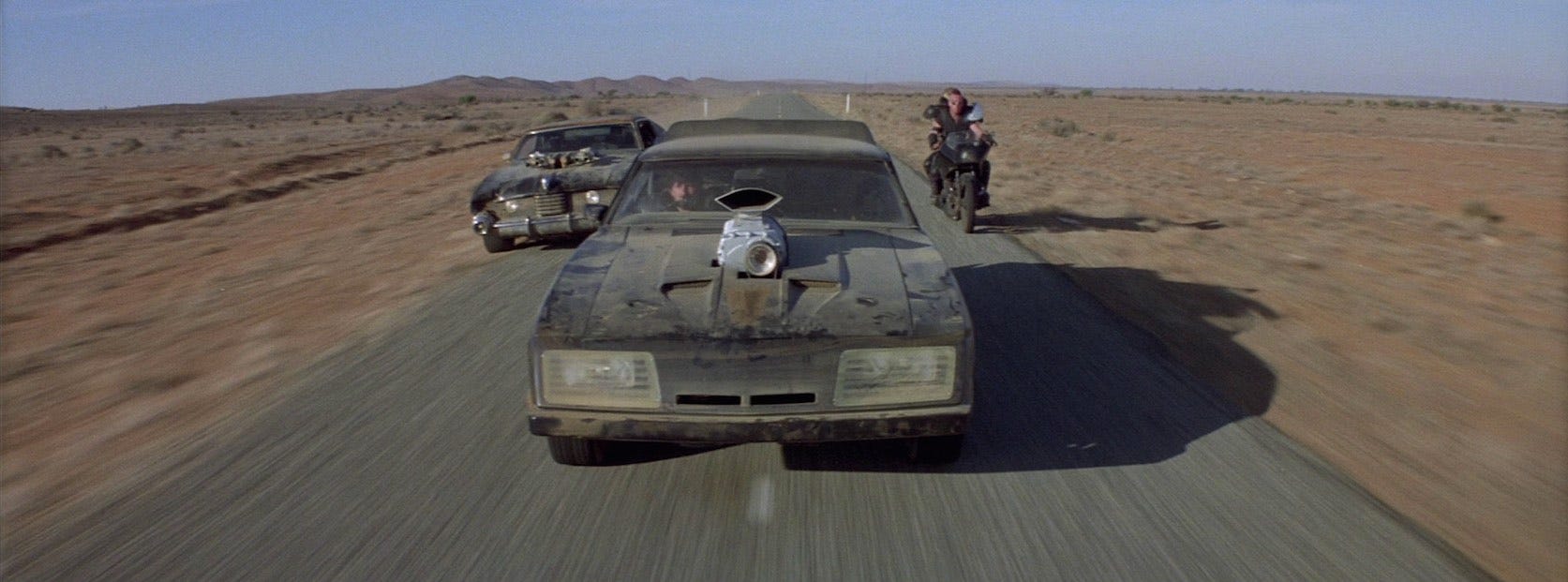
Mad Max 2: The Road Warrior is said to take place about three years after the end of Mad Max, so it’s still the late 1980s, but there’s already some confusing timeline issues that appear here. It’s difficult to tell if a nuclear war happened after the first film, as indicated not just by the look of The Humungus, but by the later films too, or if this savage world is a mix of just being out in the Australian Outback while the world is breaking down, as implied by the first film?
Anyway, a classic tale of a wandering ronin who drifts into an isolated town and sets the wrong things right, this is where the idea starts that these stories are just some oft-told post-apocalyptic legends of a man called Max. This is mostly due to the fact that we are being told this story by someone at some point in the future even farther ahead than when the rest of the film is set. We know this because of the bookend narrations: “My life fades. The vision dims. All that remains are memories.“
One of the all-time best action movies ever made, it was originally called Mad Max 2, but the title was changed to The Road Warrior for its American release, as Mad Max was much less-known, so much so, that the VHS release of the first film was labelled as “the thrilling predecessor to The Road Warrior.” Road Warrior is also the movie that sets the tone and style that most people think of when they think of the films of this franchise… the mohawks, the football pads, the wrist crossbows, the bare thighs, the desert, and the cobbled-together vehicles, on and on. First used here, these things all went on to become expected hallmarks of this world. This is also where the stunts really took center stage in the franchise too, much more than they did in the first film. This set a standard that the later films would also be known for, especially after the final act in this film, which is an extended 15-20 minute chase sequence of beautiful chaos, involving dozens of scrap-yard vehicles, including a gyro-copter.
It’s simply a fantastic film.

Mad Max Beyond Thunderdome (1985)
Recently robbed of everything he owns, Max follows the thieves to a wasteland trading post called Barter Town. A festering sleaze-pit, it’s the kind of place where, if the earth doesn't swallow you up, then Barter Town will. Soon enough, Max is caught up in a civil war between it’s two leaders, the grandiose Aunty Entity, and the king of the Underworld, the man who may actually run Barter Town… Master Blaster.
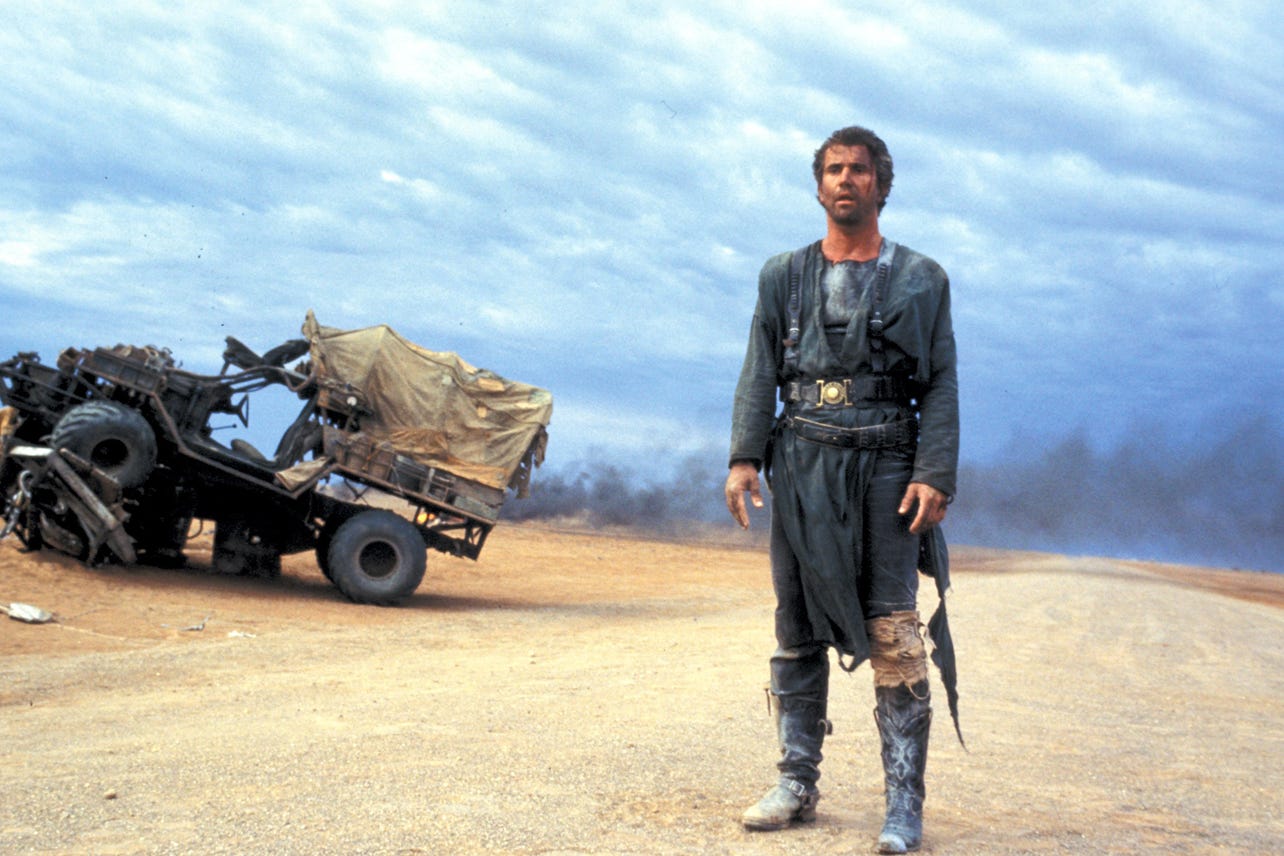
Mad Max Beyond Thunderdome takes place about 15 or so years following the events of The Road Warrior. This is known because you can see during the part with the feral orphans that Captain Walker left to seek help in 1999. So, seeing as how it’s obviously been a few years since Walker and the other adults originally left—and I love the fact that the adults all basically abandoned these dumb kids—it’s a fair guess that this film takes place at some point in the early aughts.
It’s also clear from this film that there has definitely been a nuclear war at some point in the past, but it seems to have happened more distantly than recently. Now, whether this nuclear war took place between the first and second films, or the second film and this one, is a little less clear. Either way, it’s fair to say that things have gotten worse, as not even Max has gasoline now, and Barter Town is run on pig shit. Thunderdome in general also looks closer to the world we see in Fury Road, as the styles have gotten even crazier, and the vehicles look even more cobbled together.
People like to thumb’s down Thunderdome like it’s Spider-man 3 or something, but those people are wrong. This film is awesome. Besides, there isn’t a more quoted Mad Max film out there. Everyone knows “Two Men Enter! One Man Leaves!” or “Who run Barter Town?” or “Bust a deal! Face the wheel!” or “‘Member this!” and also “I'm the guy who carries Mr. Dead in his pocket.” Plus, Tina Turner, man… Tina Turner is in this film, not only adding one of the best end credits songs ever, but as one of the best villains too. “But oh…” says Aunty Entity, “how the world turns. One day, cock of the walk. Next day, a feather duster.” I mean, just try to hear the words “Master Blaster” in your head in any way other than in Tina Turner’s voice…
But I get it. I understand why folks were down on it, the same thing happened between Aliens and Aliens 3. Everyone just wanted more of Max in the Interceptor. They wanted more of him bombing down the highways. But that’s the kind of decision that leads to stagnation, people. Don’t believe me, go ask JJ Abrams.
Actually don’t, he won’t understand what you’re talking about it.
Also, this film features a band of feral orphans, and they are terrible and dumb, and incredibly annoying, as most kid characters are in any non-kids movie. I understand that the idea is they grew up uneducated and in post-apocalyptic isolation, but they still suck. They’re still dumb. I hate them like I hate all quirky kid characters, and yes, that includes Feral Kid from Road Warrior too. Him the most of all! But take heart, my friends, because Max obviously hates these kids too, which is great. Plus, it looks like their idiot dream of escaping the wasteland only led them to the irradiated rubble of Sydney, so… I’m betting the problem solved itself soon enough.
Thunderdome is also the first movie that sees the first major actor playing a completely new role. Bruce Spence famously plays The Gyro Captain in Road Warrior, and Jedediah, still a pilot, but one who flies a plane, in Thunderdome. Some will try to say they’re the same character, but there’s nothing in this film that indicates this, and both Miller and Spence have stated multiple times that they are meant to be different characters. To me, what this does—having different but similar characters played by the same actor—is lend more credence to the idea that this franchise is nothing but a bit of wasteland scavenger oral tradition told years later around a campfire while the rat meat sizzles on a stick, yet another version of everyone’s favorite story about The Driver known as Max, and his friend The Flying Man.
Most notably, for those of us who were around back then, this was the last time we saw the man called Max. We didn’t see him again for nearly thirty years.
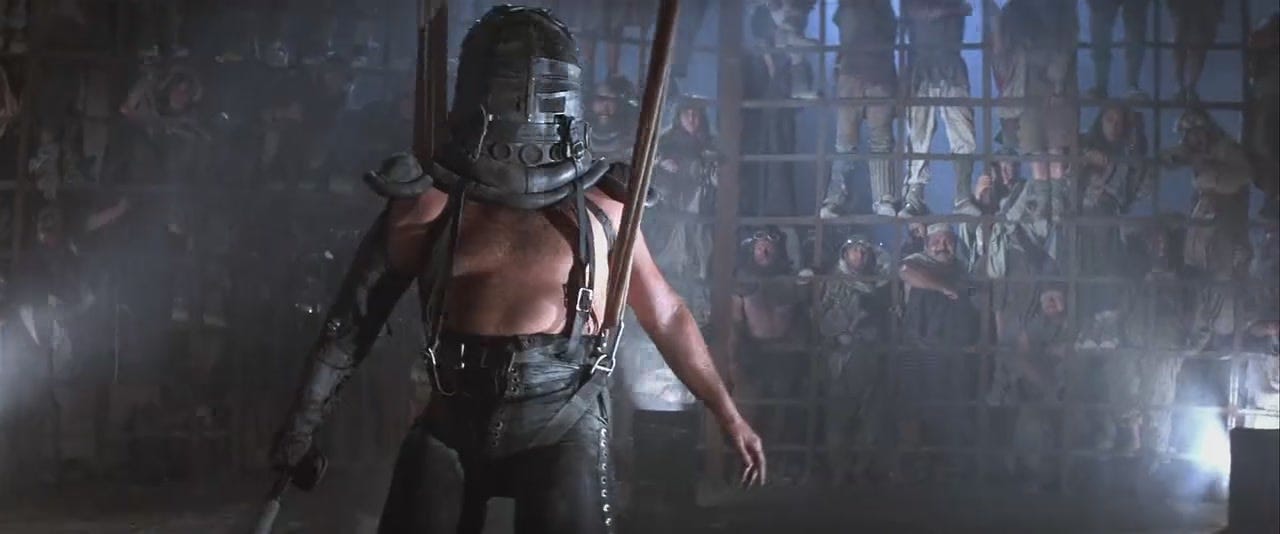
And thus, we enter this franchise’s second era…
Mad Max: Fury Road (2015)
Long years after the Oil War and the Water War, long years after the collapse of civilization, the warrior Imperator Furiosa steals the War Rig—an armored 18 wheeler built for road war—freeing the five wives of the tyrannical despot known as Immortan Joe. Along the way, she must forge an alliance with a drifter named Max, as they try to outrun the warlord and his fanatical horde of War Boys in a deadly high-speed chase across the Wasteland.
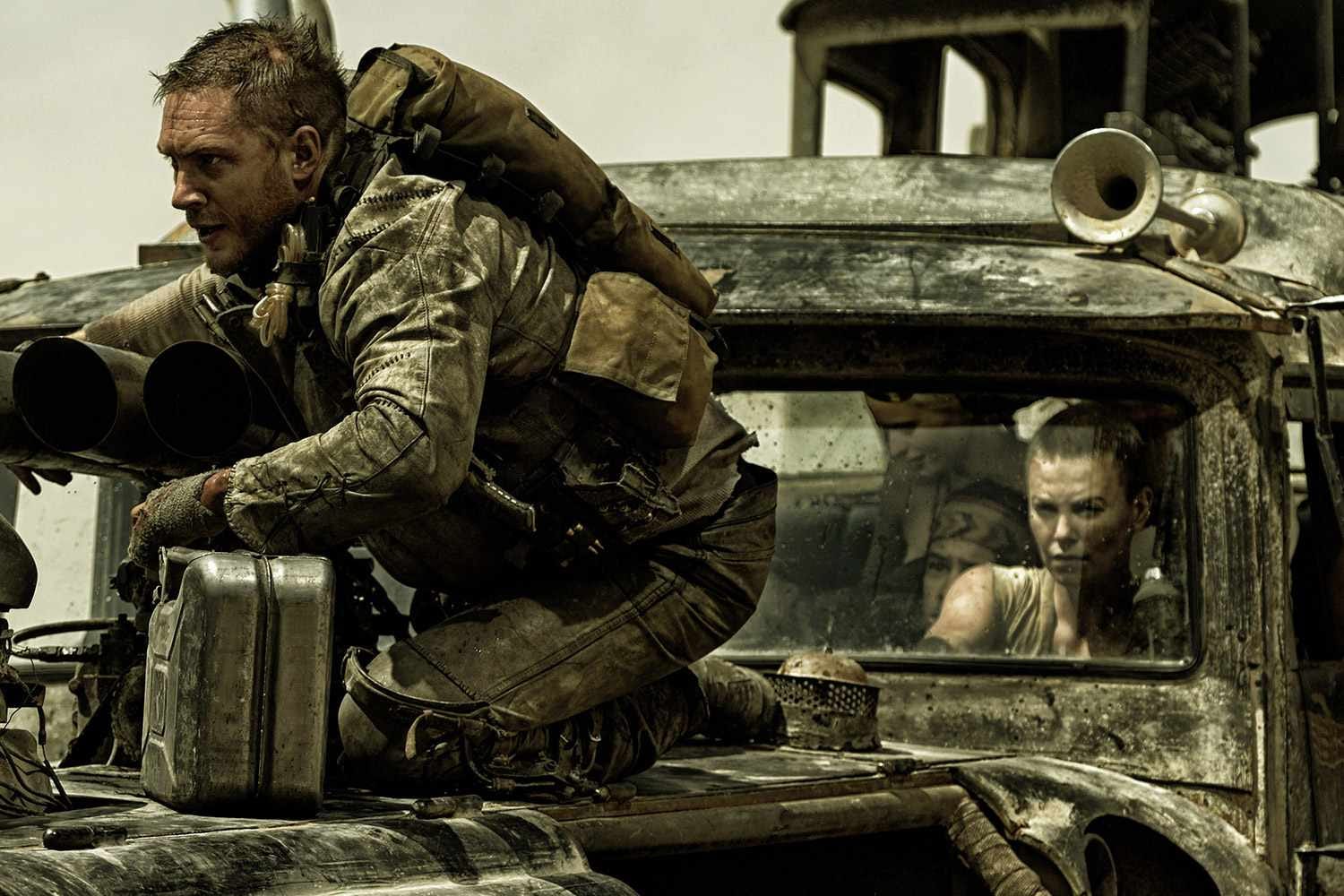
Mad Max: Fury Road is the film where any attempt to create a timeline that makes sense in the context of the original trilogy is no longer possible. The story, as well as the appearance and behavior of the characters clearly implies that it takes place after Thunderdome, most likely a few decades later, as there are even less that remains of the old world, other than the wreckage that get lashed into road war machines. Even Furiosa’s Green Place turns out to be a long lost myth. In a prequel comic, it’s implied that this film takes place in the mid 21st century, which is, by any estimate, at least 40 plus years following Thunderdome, and if that’s true (and it is), then it doesn’t make sense for the Max who appears in this film to be the same Max from the original films. Even allowing for the meta-fact that we have switched actors playing the character, as far as the in-world timeline is concerned, Max would have to be in his 80s, at least.
Plus, Max's back tattoo lists 12,045 days (or exactly 33 years), which presumably means his age, which means that if the timeline is the same, then this Max would have been born well after the collapse. Some folks use this as an opportunity to push their theory that this Max is actually Feral Kid from The Road Warrior, but again… if you’re going by the timeline, then Road Warrior happened over 60 years ago too, so that doesn’t make any sense either.
This film also features the second actor to play two different characters in two different Mad Max films, as Hugh Keays-Byrne played both the Toecutter in the first Mad Max film, and Immortan Joe in Fury Road, and there is no way that they can be seen as the same character.
So really, thinking of the various stories of the Mad Max franchise as more of a collection of myths, as tales about a fabled hero in a time that desperately needs one, being told and retold, with the details blurring into one another, is the easiest way to reconcile the many contradictions. Here, we see yet another truck escaping a horde of vehicles, just like in The Road Warrior and Thunderdome, and that truck is filled with precious cargo yet again, and while it’s the Wives in Fury Road, it was gas in The Road Warrior, and it was kids in Thunderdome. Perhaps, much like the legendary Viking chieftain Ragnar Lodbrok, while Max was most likely a real person at one point (in the universe of the films), in the years since, Max has become the name that is attributed to many different people, to the heroes who wander the wasteland, doing what’s right, saving people… and then moving on. I mean, Max has a son in the first movie, and in the flashbacks in Fury Road it’s implied that he has a little girl. How else do you reconcile that?
But all that aside, Fury Road also isn’t primarily a Mad Max film.
The movie spends more time with the one-armed warrior Furiosa, an imposing woman and veteran road warrior, who drives her War Rig on the Fury Road with a bad ass metal arm and a whole bunch of guns. The focal point of a film with a searing anti-patriarchy theme, Fury Road really begins with Furiosa. An Imperator in the army of Immortan Joe, she frees his five wives—women that Immortan Joe keeps captive and uses to try to breed healthy sons—and attempts to escape out from beneath the long shadow of the Citadel. That’s the whole film, Furiosa, along with Max and a wayward War Boy, and the Five Wives, trying to get back to the half-remembered valley Furiosa was stolen from as a child, a place that she only knows as The Green Place, the place where her mother, and the other women of the Vuvalini, rode out the apocalypse, a place where she believes they will all be safe from the men who killed the world.
There’s been tons written about it at this point, so I won’t get too into it, but as everyone knows by now, besides such details like the motorcycle tribe of warrior women in their 60s and 70s, all of whom kick a huge amount of ass in the third act, something you definitely don’t see very often in action movies, Miller also invited writer and performer Eve Ensler, author of The Vagina Monologues, someone who’s worked with abused women and sex slaves the world over, to be a consultant. Ensler said,"It was really a wonderful experience for me, and a real honor to sit with those wonderful actors and talk about issues like how do you feel carrying a baby of someone who's raped you? What does it mean to be held captive by a warlord who is using you as a breeder and raping you constantly? You know, I wanna say that you know, this a post-apocalyptic movie, but it seems to me that for many in the world, the future is now. There's many people who are living this story."
But despite this and other obvious elements that support and strengthen the feminist themes that underpin this film, there are still a bunch of whiny hipster contrarian ass-wipes out there who really hate the fact that such an unapolegetically vibrant and kick-ass and palatable-for-the-masses action film like Fury Road, manages to squeeze in a decent anti-patriarchal theme. So they get all snooty and sneery, and snidely point out that people are overstating the importance of the film’s somewhat simplistic feminist theme, much in the same way assholes do about the original Dawn of the Dead’s anti-capitalism message, and y’know what… they’re not wholly wrong either. The feminist themes in Fury Road aren’t all that complex, and are pretty easy to see. Where they’re wrong is the way they’re act like condescending gatekeepers, as if this kind of easy reader 101 stuff doesn’t serve an important introductory role in a person’s educational journey. Imagine being such an empty shell of a person that you glom onto “I was into Feminist Theory before it was cool” as your whole personality, and just because some folks saw a movie they liked and noticed its theme. Fuck you, you loser.
Alternatively, and also directly due to those same anti-patriarchal themes, there were a ton of the usual suspect misoynistic incel dipshits who were super butt-hurt because Furiosa was featured so prominently over Max in the movie, and also that the feminist themes were so noticeable, not to mention the fact that they were so celebrated in the press too, and all while the film obviously placed the blame for the destruction of the world squarely at the feet of the patriarchy. They were so mad about this. Cry more into your fedora, bitch.
And to think, we almost didn’t get this movie…
Fury Road was long considered to be a quixotic film that was never going to be finished, and that Miller was tilting at windmills. He first came up with the idea in 1987, and the film spent over a decade in development hell. They first tried to make it in the early aughts, but September 11th, the Iraq War, as well as Mel Gibson being an antisemite, led to delays and restarts and new castings. The success of the film Happy Feet in 2007 gave Miller a golden ticket in Hollywood, so he used it to get Fury Road off the ground again. Production was supposed to begin in late 2010, early 2011, but then the Australian desert had a once-in-a-century rainstorm and the Wasteland had bloomed a vibrant and living green, making its use as a Wasteland impossible, which is probably the definition of a champagne problem. But as a result, the studio started to get nervous, and in their stupid panic, they tried to stick their fingers in and fuck everything up, pushing Miller to shoot the film on a soundstage and use VFX, so the filmmakers pretended not to see those emails, and instead shipped everything to the Namibian Desert, and then didn’t mention it until the vehicles were already there, and when the Studio found out, (I assume) they were like “Crikey, I guess we really ballsed it up, eh, mate? No wucka, do’ya wanna to send a check for us to ship all this back to Oz, or…?”
In the end, this was a film that defied the myriad odds arrayed against it… man, nature, money, time, the studios… and then went on to become easily one of the best action films ever made, and not just of that year either, but possibly ever.
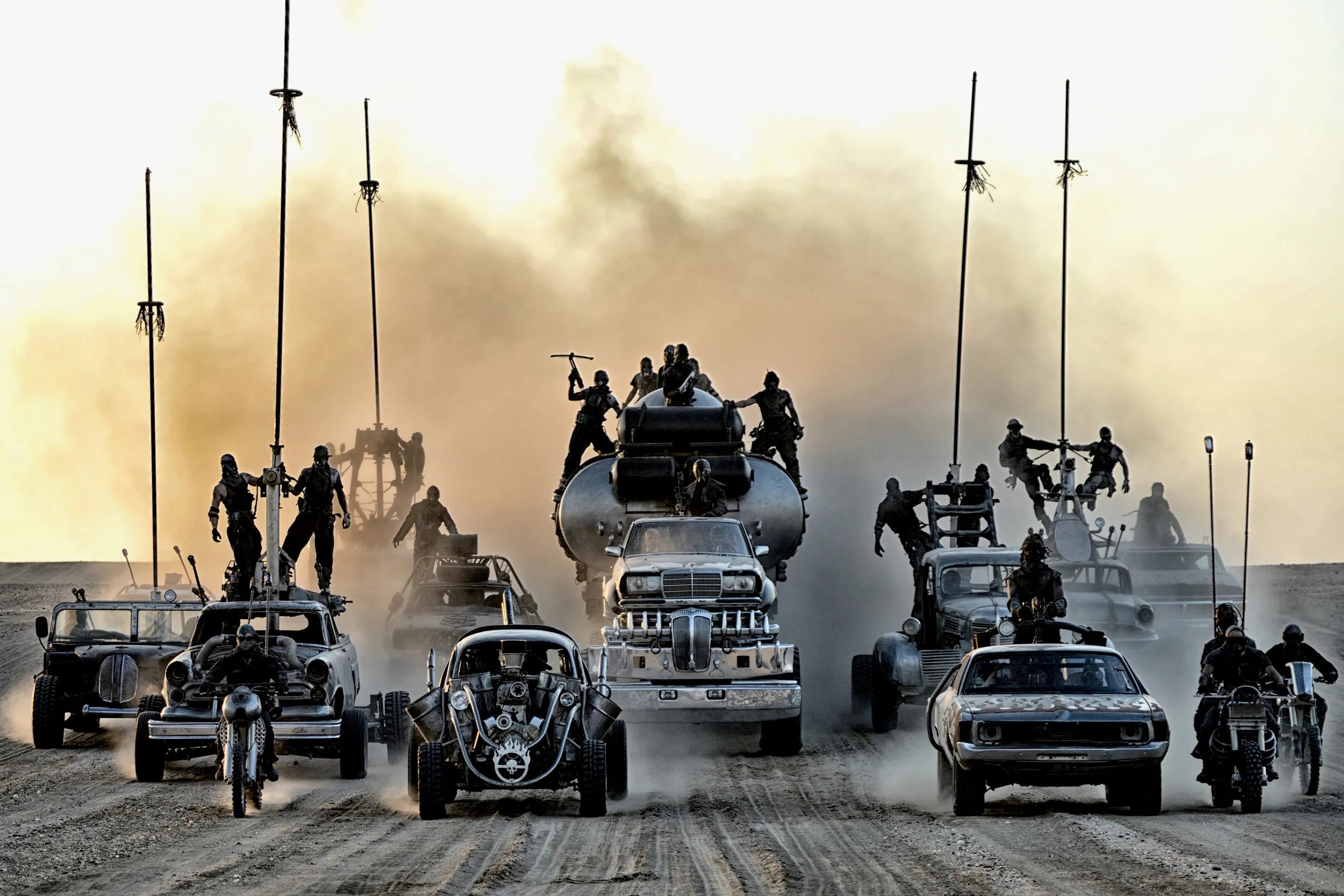
And on top of that, this is a film that also shows pretty clearly that the whole timeline discussion really only has one answer… It doesn’t fucking matter.
But I digress…
Furiosa: A Mad Max Saga
Telling the story of how young Furiosa is snatched from the Green Place of Many Mothers, and how she first fell into the hands of a great biker horde led by the warlord Dementus, and then finally to the Citadel, where she joined the army of the Wasteland tyrant Immortan Joe, this is the story of how she became the Imperator Furiosa, all while trying to make her way home again.
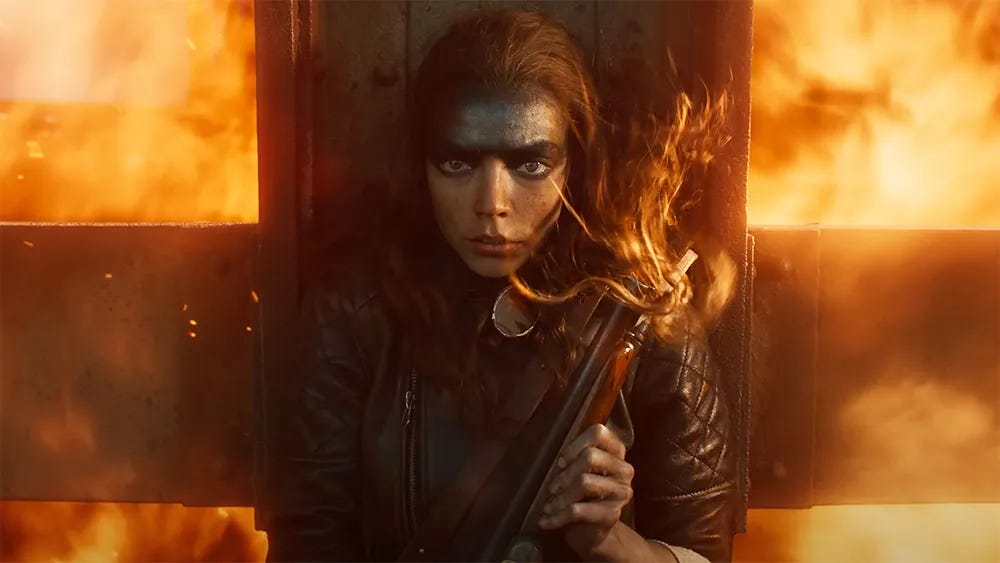
This is a story about the road to vengeance, and how ultimately unsatisfying that kind of life is. It is the story of how a child became the hardened warrior who forged her own destiny. It is a tale of the crucible that is the Wastelands.
The timeline for when Furiosa takes place is pretty easy to see, as it’s obviously a prequel that takes place in the years before the events of Fury Road, one that seems to span about two decades, I think. Well after Thunderdome, definitely. Regardless, right away you already know how things will basically end up, and even the dullest amongst us can easily guess at what point this film will end. This is basically the problem with all prequels, and often times this alone is more than enough to render the whole story inert. Only a few notable exceptions have been well-written enough that, despite the fact we’re aware of the destination, the journey still ends up being one hell of a ride.
Furiosa is one of these exceptions.
So, as it should, the film starts at the beginning, with Furiosa getting snatched, and while again, you know what’s going to happen, it’s a thrilling sequence, and you can’t help but hope she escapes. And even though you know she won’t escape, you still find yourself worrying that the Green Place stays a secret. In the end, the main thing this opening clearly illustrates for you is that this is a world where mercy gets you killed.
This is how we first meet Dementus.

A mustachioed, vainglorious clown of a warlord, a nomadic conqueror traveling the wasteland at the head of a horde of wild biker scum killing or absorbing every other gang he comes across, Dementus stands firmly rooted at the intersection of doomsday prophet, smarmy politician, swindling showman, and an eagerly murderous lunatic. Hemsworth is truly fantastic in the role.
With the young Furiosa as both his prisoner and his surrogate daughter, Dementus and his horde eventually come across the Citadel. The Citadel is the trio of mesas from Fury Road. Rising high above the wastelands, their upper reaches connected by high walkways, they are topped with greenery and wind turbines, and holed with cool caves, while sitting atop a deep aquifer. Along with Gas Town, a gleaming old metal refinery sitting atop a lake of oil, and the Bullet Farm, a dusty and strip-mined hole in the ground of a lead mine, it is the primary fortress of the Wasteland.
Dementus wants it all, of course. So, he and his horde roar in there, all bluff and bluster and revving engines, scattering the grubby little peasants that cling to the Citadel’s base, sending them back into their holes where they feed on flyblown piles of human flesh.
But The Citadel is already owned by Immortan Joe, a pustulant post-apocalyptic Trumpian maggot of a warlord, the God-head of all he sees. Backed by his War Boys, a chalky and tumor-ridden multitude of suicidal fanatics all ready to die in the name of their leader, he sits on the high seat here, and his forces are more than ready to deal with the likes of Wastelander trash like Dementus.
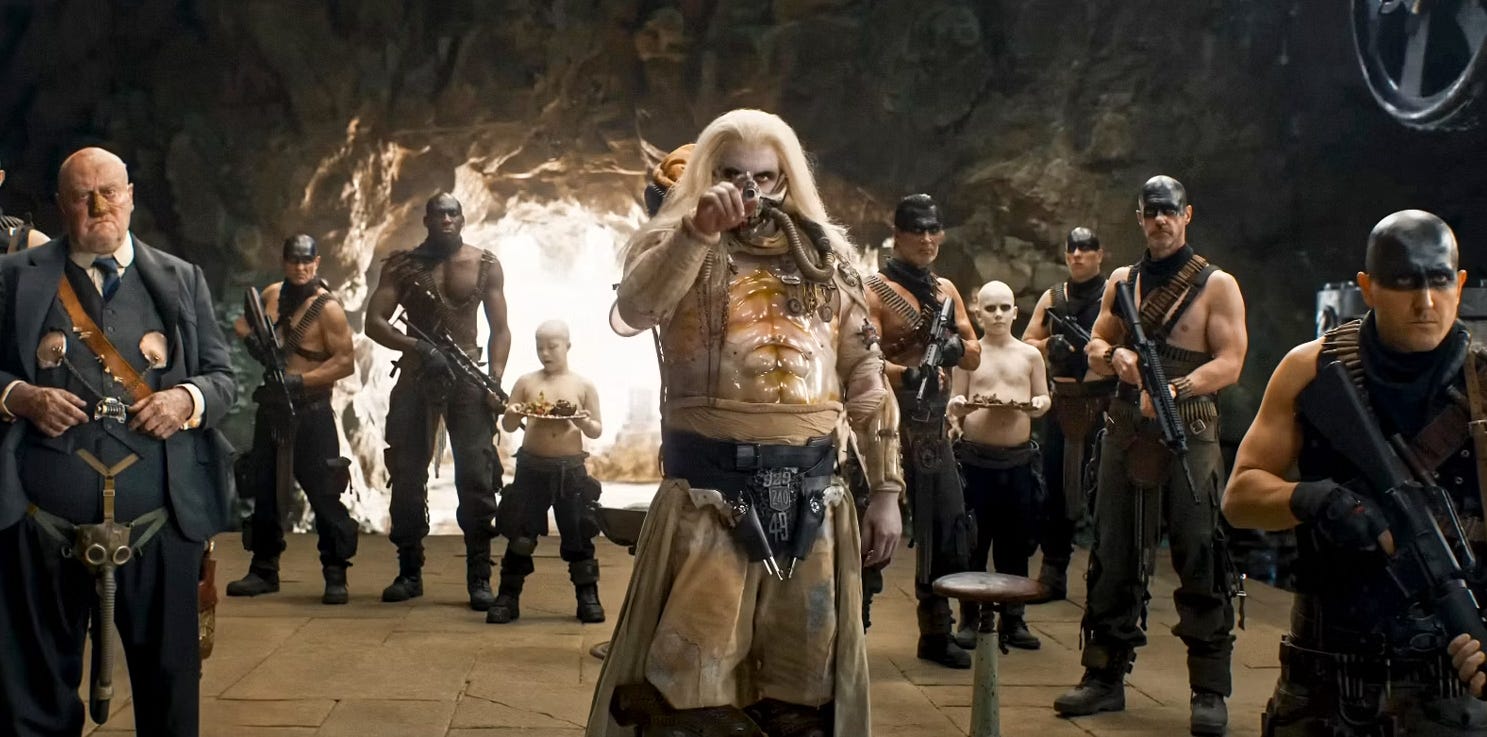
The Citadel sends Dementus’ horde running.
After that, some guerilla warfare ensues, culminating in Dementus and his horde taking Gas Town, and cutting off Immortan Joe’s access. This brings Immortan Joe to the table, and during the negotiations, young Furiosa is sold to the Citadel. Faced with the prospect of becoming one of the wives of the Citadel, Furiosa escapes into the warren of tunnels, and blends in within the ranks of the workers. Years pass.
This is how Furiosa becomes a part of the War Rig.
A thing of terrible apocalyptic beauty, and the greatest beast to ever drive the fury road, this is also how Furiosa meets the man known as Praetorian Jack, a man who might have once been known as Max. Maybe. Maybe not. Either way, it seems like the actual Max also makes a cameo appearance. Both of these characters, Praetorian Jack, the man who takes Furiosa under his wing, protects her, and teaches her about road war, and the other Max, the one leaning against a black Interceptor, who helps her when she is lost in the desert, are probably the starkest examples so far of how Mad Max is not just one man, but the name of a legend applied to many.
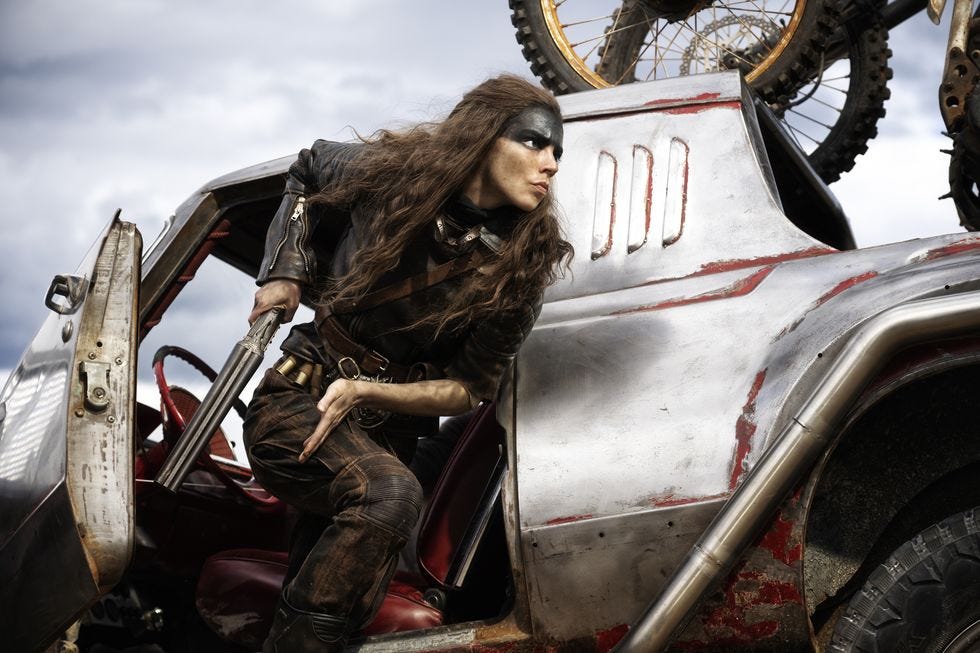
Side Note: Just to add to the unreality of the Mad Max stories, and the way that they seem to exist as oft-retold legends that grow and change with each re-telling, and also to highlight how George Miller ultimately doesn’t give a single fuck about a straight forward linnear narrative continuity… the role of Mr. Norton, one of Dementus’ chief captains, is portrayed by Elsa Pataky, Chris Hemsworth’s wife. She also plays the role of the Vuvalini General in the beginning of the film, the character who sees Furiosa’s mom off when she sets out to try to free Furiosa from her kidnappers.
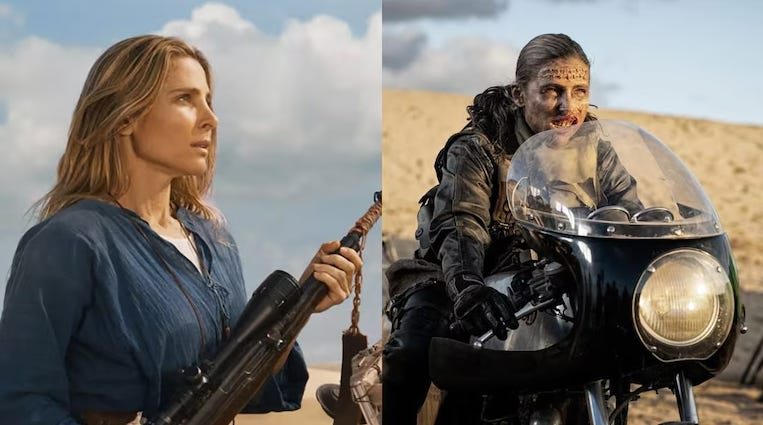
Again, as the Leader of the Great Northern Tribe says at the beginning of the film The Road Warrior: “My life fades. The vision dims. All that remains are memories...”
Anyway, the battles are amazing. The war rig thunders down the fury road in all its shining chrome glory, bristling with weapons, as cranes and spinning iron balls whirl, and the biker bandits, using parasails, moto-gliders, those big fan flying rigs, and even a huge octopus-shaped kite, fling exploding spears from above, trying to bring the rig down. It is yet another example of a pedal-to-the-metal truck roaring down the road, beset on all sides not just with lethal junk cars, but by flying machines too, echoes of Mad Max stories of the past. Because of all of this, Furiosa and Praetorian Jack, their foreheads smeared with oil, become more than friends, more than parent and child, more than lovers, they become road partners.
Meanwhile, because he only knows how to destroy, Dementus is running the Gas Farm into the ground, and Immortan Joe, along with his generals, the leprous People Eater and the psychotic Bullet Farmer, wants to go to war. Unfortunately, Dementus is one step ahead of their plans. When he takes over the Bullet Farm too, trapping the war rig inside, because of their bond, Furiosa cannot abandon Jack. This is a fateful moment, because one thing is true in all of these films… everyone crashes eventually.
This is how Furiosa loses everything to Dementus, including her arm. When she finally shaves her head and builds her metal arm, it’s to end the war and extract her vengeance, and she plans to do so by taking Dementus’ head. But when she finally catches up to the man, that’s where we see Furiosa finally fully embraces who she is, not as a destructor, not as the fifth rider of the Apocalypse, but as an agent of change, one that refutes the dead-end violence that suffuses this blood, smoke, and asphalt-choked post-apocalyptic nightmare world. There’s some action here, yes, but it’s not the point. Instead, we get an anguished debate over the endurance of grief, and of the fleeting satisfaction of violent retribution, and instead of taking the blood that she has long thirsted for, we see Furiosa rejects the hard lessons she learned at her mother’s death, and instead, chooses a kind of mercy.
Now, some might call it a more cruel fate than death that she gives him, maybe, and it’s certainly an inventive one, and definitely one that not fits in with the harsh world these characters live in, but most importantly, its a fate that implies a better future. It’s all about refuting the old bullshit, and the way things have always been done, and instead trying to grow something new and good in the ashes of the old world. This is intended to be seen as Furiosa deliberately planting the seed of her own redemption. This decision leads us right into Fury Road. Since we already know that her quest will ultimately end with her choosing to build a new world in the Wastelands, the whole point of this film is to show us the long hard road she took to get to that point.
In many ways, this is the same road that Max took, one that began with him losing everything in the first film, Mad Max, and continuing into The Road Warrior, where he finds a reason to live again. Here, Furiosa comes out the other side of her grief and her anger and her need for bloody vengeance, and discovers that she can be someone else, someone who stands up, someone who saves others, someone who decides to make a better world.
This perhaps clarifies why this film is called Furiosa: A Mad Max Saga (besides the obvious IP requirements of it being part of a franchise, of course), and it’s because Furiosa is also a Max, as this story is yet another tale of a hero who was broken and reforged on the blood-soaked roads of the Wastelands. It’s also a story that you may have heard before, just told in a slightly different way, with slightly different details...
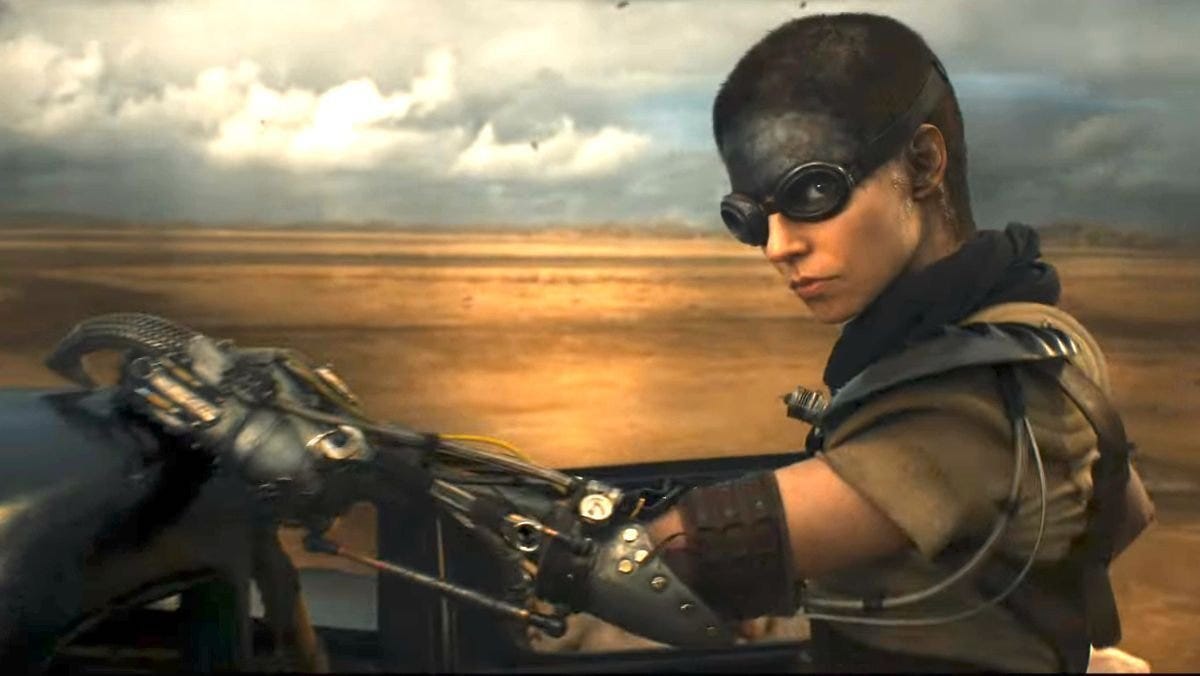
So, if I had one complaint about the film, it would be this…
While I completely understand Furiosa’s decision to free Immortan Joe’s wives and attempt to escape back to the Green Place, I wanted to see it happen on screen more. I wanted to see her make the connections, and to begin to execute the plan. I wanted to see her not only look upon the world she has found herself in, and reject it, but to also realize that she now has the chance to do that which her mother tried to do for her all those long years ago.
In The Road Warrior, there’s a moment where Pappagallo confronts Max. He is trying to get Max to drive the tanker truck out of the compound when they try to break free of The Humongus’ siege, and Max is like “not my problem,” and Pappagallo says…
“What is it with you, huh? What are you looking for? C'mon, Max, everybody's looking for something. You're happy out there, are you? Eh? Wandering? One day blurring into another? You're a scavenger, Max. You're a maggot. Did you know that? You're living off the corpse of the old world. Tell me your story, Max. C'mon. Tell me your story. What burned you out, huh? Kill one man too many? See too many people die? Lose some family? …Oh, so that's it, huh, you lost your family? That makes you special or something, does it?”

And this moment is important because it highlights the selfishness of Max’s life. It highlights how Max is just the same as Humongus and his horde outside the walls of the encampment, all of them using the tragedies that befell their lives as an excuse to hurt others, while also highlighting that everyone’s life was hit with tragedy, everyone is feeling pain, and that feeling that pain does not make you special, and it does not give you the right to inflict more pain on others. It states clearly that a good person seeks only to lessen the pain of others, despite their own. This is the seed to Max deciding to live again, to fight.
Furiosa needed a moment like this, something that was more clearly connected not just to the end of Dementus, but also to the beginning of her own life, to her mother sacrificing herself in an attempt to save Furiosa, and most importantly, to the idea that she can save the wives from the dark fate that awaits them in the Citadel. As it is now, it doesn’t have this moment.
This is a big long movie, one that feels like there’s probably a longer and better version still, but as it is now, Furiosa hardly spends any time at all with the wives. She’s barely in the room as a kid before she runs away, and that crew looked like a completely different crew from the ones she frees in Fury Road, so I feel like she really needed to interact with them more in general. The ending really would’ve benefited from them showing these characters bond, and how they all ultimately decide to run, something to create a more tangible line from Furiosa’s decision, to Furiosa executing the plan. The play off the traditional Biblical imagery was good, don’t get me wrong, it was clear in its intent, but it wasn’t enough. As it’s presented now, it all seems a little rushed and out-of-nowhere, as if the filmmakers suddenly realized that they were at the 2 hour and 10 minute mark and needed to wrap this shit up, and figured, fuck it, right? Everyone knows what happens here, right?
But for me, this is a shockingly huge and under-developed part of the story. Because Furiosa doesn’t seem to have any connection with the wives from Fury Road at all, at least not until the very last scene, so the film’s denouement just feels like a sour note in an otherwise great movie.
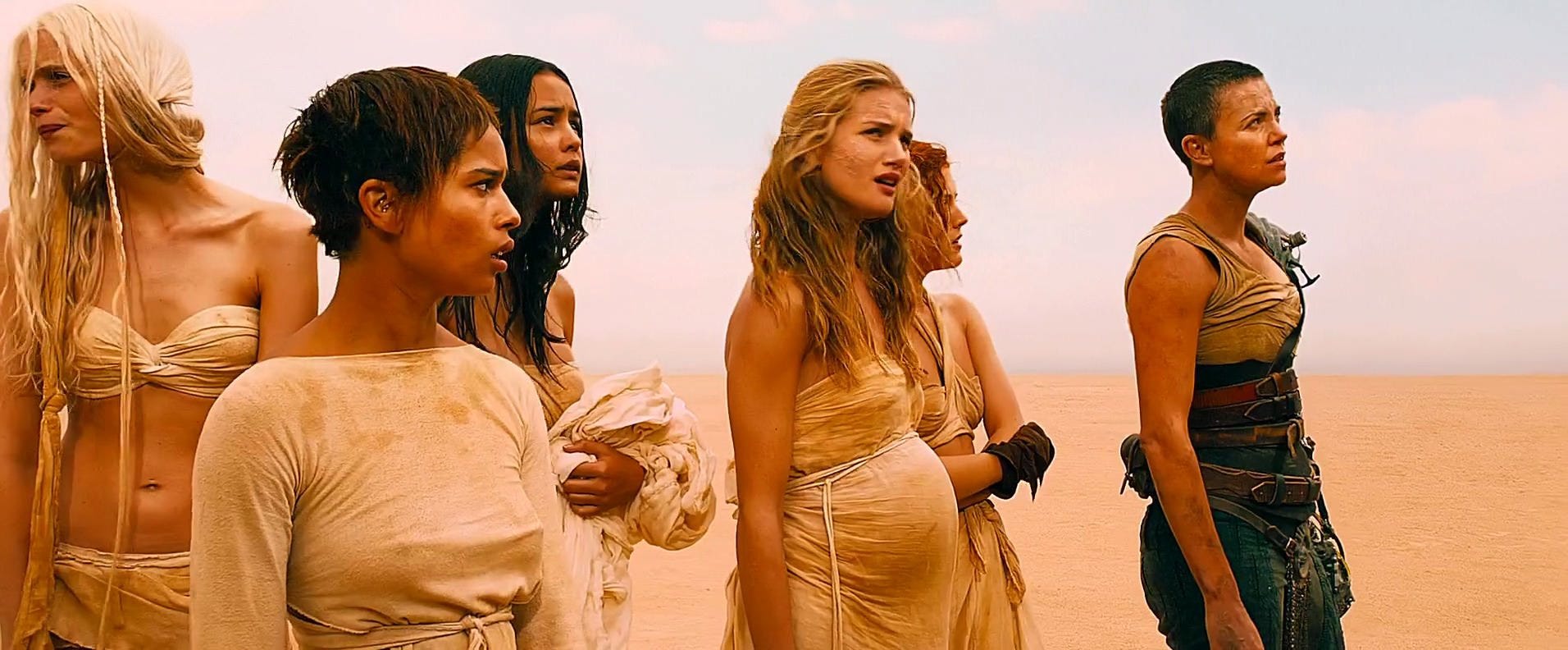
And if I was going to have two complaints about this film, my second one would be this…
The end credits has clips from Fury Road in it, and I hate it. It feels like the result of cowardly desperation on the filmmakers’ part to me, almost as if they were so afraid of letting Furiosa stand on its own that they just had to remind us of the greatness that is Fury Road right then. It’s true Furiosa is no Fury Road, but not in any kind of bad way. It’s still a great film. So, I know it’s a small thing, but god damn, I hated it. I hated it so much. Because of this, I’d almost advocate for the release of a director’s cut where everything is basically the same, except they’ve cut out all of the Fury Road clips from the end credits. Of course, to be clear, I’d ALMOST advocate for it, because, y’know… I don’t want to be lumped in with the kind of bigots and assholes who pushed for the Snyder Cult.
Besides, in the end, it’s easy to ignore these complaints.
Because Furiosa is amazing. I loved it.
Miller is reveling in this world, and his passion is a blast to watch. It’s exciting. It’s fun. It’s cool-looking. Even if I already wasn’t a huge sucker for Road Warrior movies, I would’ve absolutely loved the way he expanded on this world. And on top of all that, despite knowing full well that Furiosa survives, this is a film of such well-crafted set pieces, such thrilling moments, that you often forget she is basically always safe, or at the very least, you’ll often find yourself wondering: “How the hell is she going to get out of this.”
In the end, it’s just a really good time, and all while illustrating the eager, barely contained savagery of a patriarchal society, as well as the toxic fecklessness of our own leadership caste. In the preening psychopath Dementus, in the tyrant Immortan Joe, in the lecherous People Eater, and the violent idiot that is the Bullet Farmer, we are shown a twisted mirror of our world, a place ruled by a group of unqualified, over-privileged simpletons and lunatics, each one more willing than the last to throw us all away, and all for nothing more than the barest promise of power, or the fulfillment of their own simple base needs, a bunch of eating/shitting/fucking garbage monsters, and we’re all at their mercy.
Ugh.
Anyway, there’s a character named Piss Boy in this film. His job is to climb out onto the hood of the War Rig as it’s speeding down the road during a battle, with sloshing jugs of urine on his back, which he then pours into the War Rig’s overheating radiator.
So, what more could you possibly ask for?
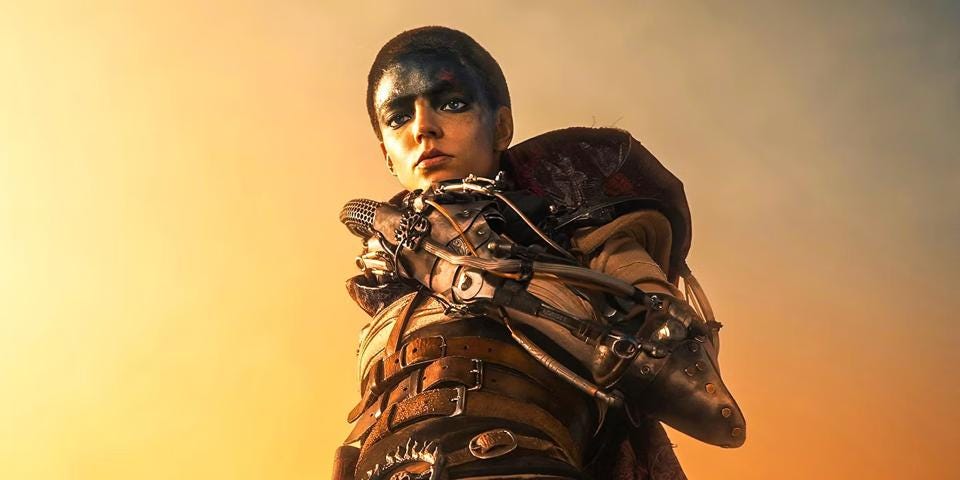
So yeah, like Dune 2, I will definitely be watching this again soon-ish, something I rarely have time for anymore, because I loved it. It’s awesome.
